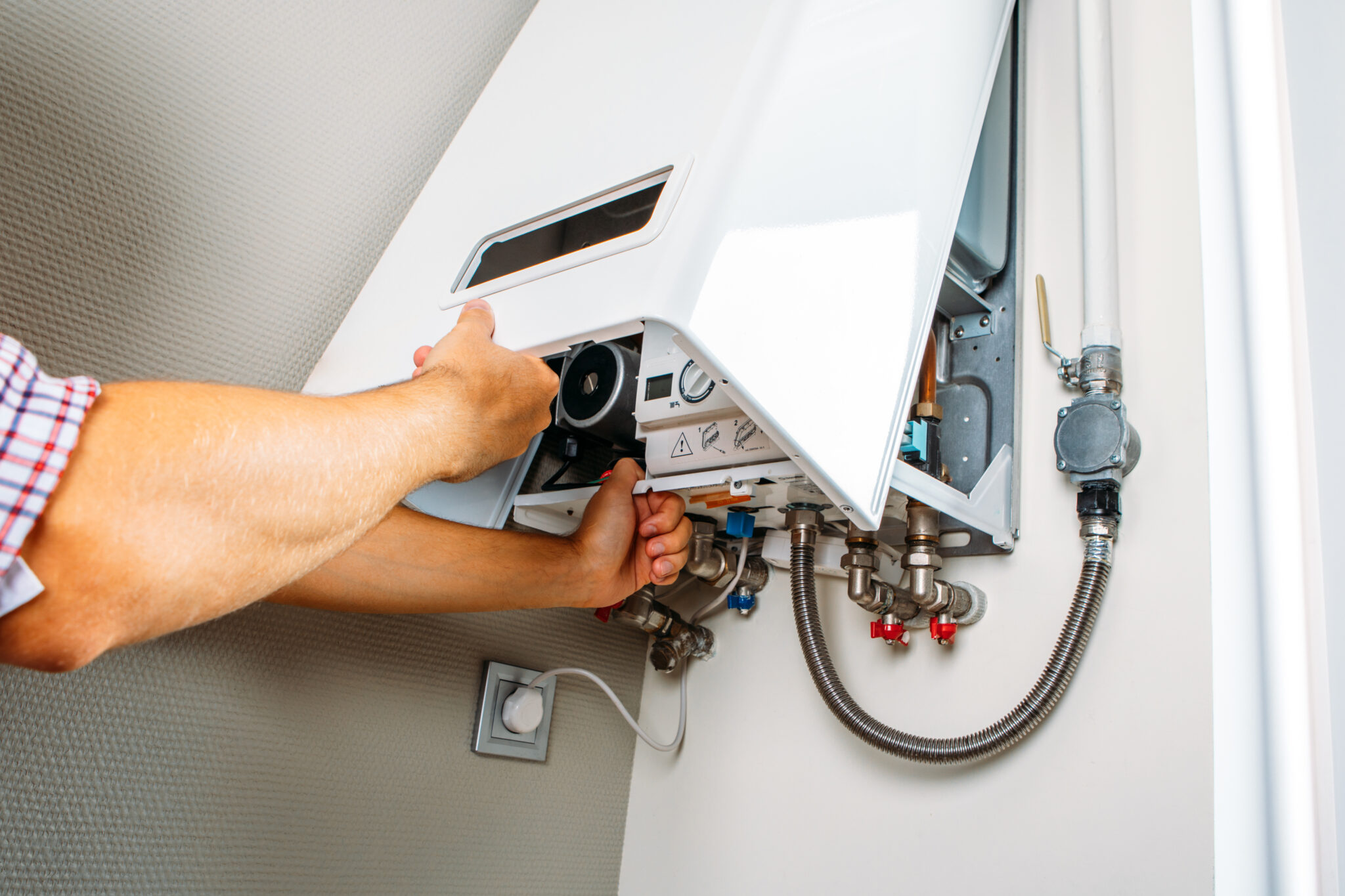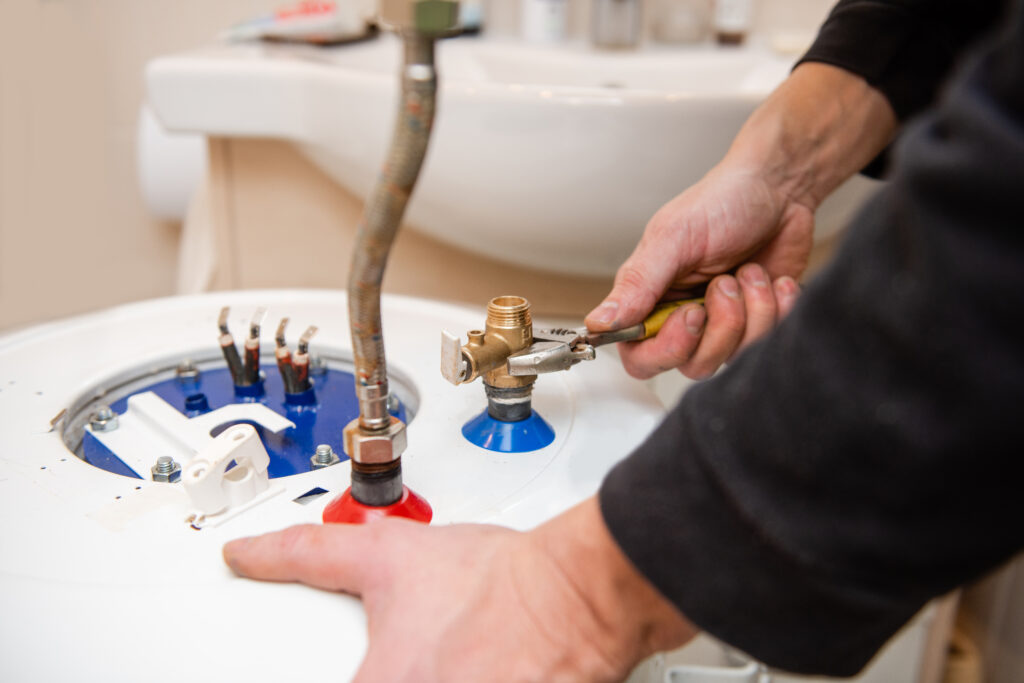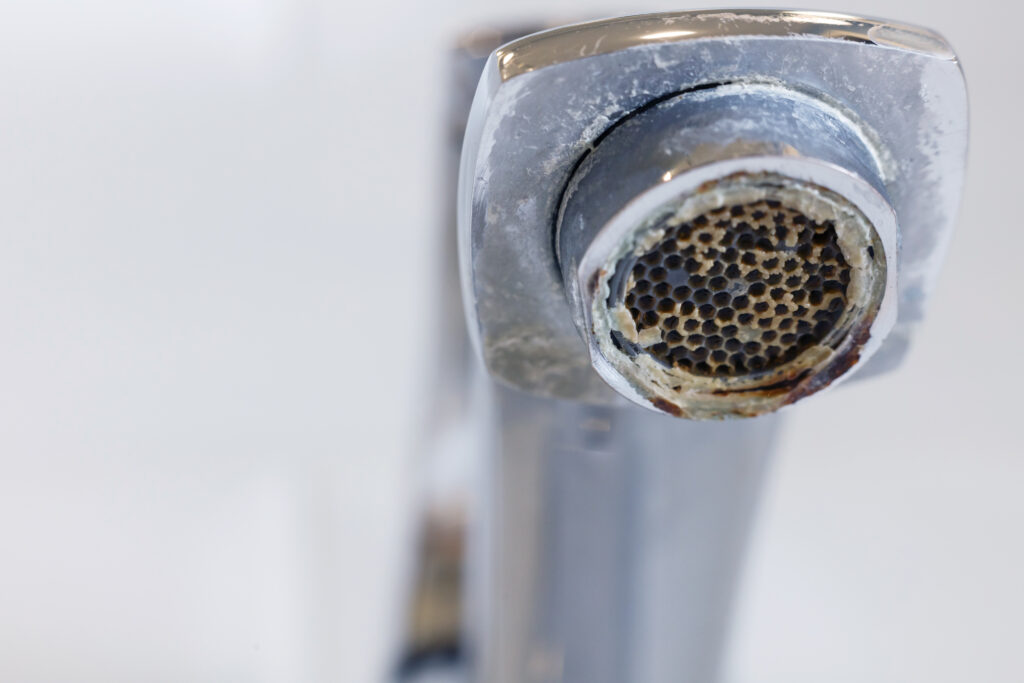Tankless water heaters have been gaining popularity in recent years as a more efficient alternative to traditional tank water heaters. That being said, tank water heaters are still widely used in many homes and businesses. So, what exactly is the difference between these two types of water heaters? And which one is right for you? In this blog, we’ll compare tankless water heaters and tank water heaters and help you decide which one is best for your needs.
Key Differences: Tankless vs Tank Water Heaters
Deciding between a tank and tankless water heater for your home requires balancing cost, energy efficiency, and lifestyle needs. Both systems have pros and cons; understanding these can help you decide which model fits your home life.
Energy Efficiency and Functionality
Tankless water heaters, often referred to as “on-demand” units, heat water directly without using a storage tank. When you turn on the hot water tap, cold water travels through a pipe into the unit, where it’s heated by either a gas burner or an electric element. This process can lead to substantial energy savings because it removes the standby energy losses that happen with tank storage heaters. Basically, you’re not paying to heat water you aren’t using. Over time, these savings can offset the higher upfront cost of tankless units, making them an attractive option for energy-conscious homeowners.
On the flip side, traditional tank water heaters store and preheat a certain amount of water in a tank, usually ranging from 20 to 80 gallons. Hot water is drawn from the top of the tank, and new cold water fills from the bottom to be heated by a burner lit by a pilot light. This means the unit works to maintain the water temperature 24/7, leading to higher energy use and costs, especially during colder months or in homes with high hot water demand.
Capacity and Demand
The size of a tank water heater is determined by its storage capacity, usually measured in gallons. This means that once the hot water stored is used up, it takes time for the unit to refill and heat more water. In large households or homes with high hot water demand, this can result in cold showers and waiting times.
Tankless units, on the other hand, have a continuous supply of hot water as long as they are functioning properly. The flow rate, measured in gallons per minute (GPM), determines how much hot water the unit can provide at once. This means that even if several faucets or appliances use hot water simultaneously, there is no need to worry about running out.
Space Considerations
For homeowners who are tight on space, the difference in size between tank and tankless water heaters is also an important factor. Tankless units are much smaller and can be mounted on a wall, freeing up valuable floor space in your home. This feature is particularly beneficial in smaller houses or apartments with scarce space.
With their larger footprint, traditional tank water heaters require a dedicated space, like a basement or utility closet. If your home already has the space for it and you’re not pressed for extra storage, the size of a tank water heater may not be a big concern.
Now that we have covered some of the main differences, let’s take a deeper look at the specifics of each type of water heater.
Cost Comparison: Tankless or Tank?
The first thing many homeowners look at when considering a water heater is the cost. While tankless units tend to have a higher upfront cost, they can save you money in the long run. Here are some important cost considerations to keep in mind:
Installation Costs
Tank Water Heaters: The installation cost for tank water heaters is generally lower, partly because they are compatible with most existing setups. The average unit and installation cost can range from $906 to $1583, depending on the unit’s capacity and whether you’re replacing an old unit or installing a new one. These costs can be higher if plumbing modifications are needed.
Tankless Water Heaters: Tankless models often require a higher initial cost for the unit and installation, ranging from $1,833 to $3,910. This variance in price is due to the need for electrical upgrades, new venting requirements, and possibly the installation of additional gas lines. The complexity of the installation and the model’s capacity can also increase the total cost.
Operational and Maintenance Costs
Tank Water Heaters: Although less expensive upfront, traditional tank water heaters are generally more costly to operate due to their lower energy efficiency. They continuously heat and reheat water to maintain a set temperature, leading to higher energy consumption.
Tankless Water Heaters: Tankless water heaters are more energy-efficient, as they heat water only on demand, which can translate to substantial savings on energy bills over time. According to the U.S. Department of Energy, tankless water heaters can be 24% to 34% more energy efficient for homes that use less than 41 gallons of hot water daily. However, they require annual maintenance to remove mineral scales, and a water softener may be needed to prevent damage from hard water.
Rebates and Tax Incentives
Tank Water Heaters: Rebates for tank water heaters are less common, though some utility companies may offer incentives for models that meet specific energy efficiency criteria.
Tankless Water Heaters: Many governments and utility providers offer rebates and tax incentives for installing energy-efficient tankless water heaters. These incentives can help to offset the higher initial cost. It’s worth checking local and state programs for potential savings.
Government Regulations
Recently, there has been an increased focus on energy efficiency and environmental impact in the construction industry. As a result, government regulations are constantly evolving to promote more sustainable practices. The Biden administration has put forward a bill that would essentially ban the use of non-condensing gas tankless water heaters. The bill requires tankless water heaters to have a 91% efficiency rating or higher, while the maximum efficiency of current gas tankless water heaters is around 85%.
While this bill would not set in until 2029, it highlights the growing importance of energy efficiency in water heaters. A great option to make sure your water heater is compliant with these potential regulations is to choose an electric tankless unit. These units have higher efficiency and are not affected by the proposed ban on non-condensing gas tankless water heaters.
Tankless vs Tank Heaters: Maintenance and Lifespan
Another factor to consider when choosing between tankless and traditional tank water heaters is maintenance and lifespan. Take into account the following points to help you make your decision.
Maintenance
Tank Water Heaters: These units require routine maintenance to uphold their efficiency and prevent potential damage. Critical tasks include draining the tank to get rid of sediment build-up, which can affect the heater’s performance and lifespan. Additionally, inspecting and possibly replacing the anode rod periodically is important. This rod helps prevent tank corrosion and extends the unit’s usable life.
Tankless Water Heaters: Maintenance for tankless models involves annual descaling, particularly in areas with hard water, to prevent the accumulation of minerals. Regular cleaning of filters is also recommended to ensure the best performance. Although tankless heaters may need less frequent maintenance, the care they do require is specific and cannot be overlooked.
Lifespan
Tank Water Heaters: The lifespan of these heaters typically ranges from 10 to 15 years. Continuous operation and the corrosive effects of storing water can shorten their durability over time. Regular maintenance is key to extending their life as much as possible.
Tankless Water Heaters: By heating water on demand and avoiding the need for constant water storage, tankless water heaters often have a longer lifespan, potentially exceeding 20 years. This durability stems from reduced wear and tear, as the unit operates only when hot water is required.
As you can see, there are several important considerations when choosing between tank and tankless water heaters. If you are still on the fence, we’ve put together a comprehensive pros and cons list below to help you make an informed decision.
How to Choose Between Tankless and Tank Water Heaters
Follow this pros and cons list to better understand which type of water heater may be best for your needs:
Tank Water Heater Pros:
Lower Initial Cost: Generally cheaper to purchase and install compared to tankless models.
Simplicity: Easier and less expensive to replace, fitting into the existing setup without major modifications.
Reliability: Can supply hot water to multiple fixtures simultaneously up to its capacity.
Familiar Technology: Well-understood, tried, and tested technology that plumbers and technicians are familiar with.
Tank Water Heater Cons:
Higher Operational Cost: Less energy-efficient since it heats and reheats water at a predetermined temperature, leading to higher utility bills.
Bulky: Requires a significant amount of space for installation and cannot be placed outside.
Limited Hot Water Supply: Can run out of hot water during heavy usage, requiring time to heat a new tank of water.
Shorter Lifespan: Typically lasts between 10 to 15 years, which is shorter compared to tankless models.
Tankless Water Heater Pros:
Higher Energy Efficiency: Only heats water on demand, leading to significant energy savings and lower utility bills over time.
Continuous Hot Water Supply: Provides an unlimited supply of hot water, ideal for families or high-demand use.
Saves Space: Compact size allows installation in smaller or tighter spaces, including walls.
Longer Lifespan: These can last up to 20 years or more, making them an excellent long-term investment.
Tankless Water Heater Cons:
Higher Initial Cost: More expensive upfront purchase and installation costs, especially if upgrades are needed for your home’s electrical or gas systems.
Complex Installation: This may require significant changes to your home’s plumbing or electrical setup.
Inconsistent Water Temperature: You may experience a “cold water sandwich” effect or variations in temperature during multiple hot water demands.
Hard Water: Can be susceptible to mineral buildup and requires regular maintenance or a water softener.
Government Regulations: There may be future regulations that would make gas tankless water heaters unavailable.
We hope you found this comparison between traditional and tankless water heaters helpful in determining which option is best for you and your home. Remember to consider the size of your household, hot water usage patterns, budget, and any potential future changes or regulations before making a decision. If you need professional help or advice, don’t hesitate to reach out to Nearby Plumbing for expert guidance and services.
Made a Decision? Let Nearby Plumbing Install Your New Water Heater
If this post has helped you make a decision about which water heater is best for your home or business, let Nearby Plumbing help install it. If you are still unsure, we can provide expert advice and guidance to help you make the right choice. We offer professional installation services for both tankless and tank water heaters, ensuring that your new unit is installed correctly and efficiently. Our experienced technicians can also provide maintenance and repair services to keep your water heater running smoothly. Contact us today for all your water heater needs!





